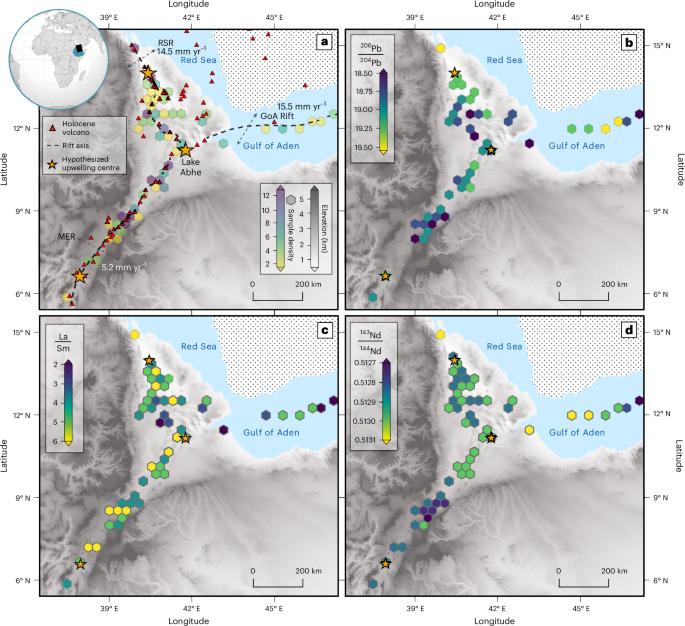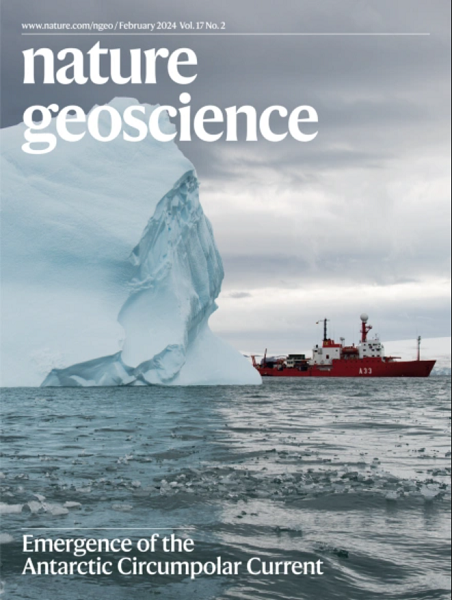Mantle upwelling at Afar triple junction shaped by overriding plate dynamics
IF 16.1
1区 地球科学
Q1 GEOSCIENCES, MULTIDISCIPLINARY
引用次数: 0
Abstract
Mantle upwellings drive large-scale surface volcanism and facilitate continental breakup and ocean basin formation. However, the spatial characteristics and internal composition of these upwellings alongside how they are modified by plate tectonics are poorly resolved. Afar, East Africa, is a classic triple junction comprising three rifts at various stages of evolution thought to be underlain by a mantle upwelling or plume, allowing examination of the controls on the mantle upwelling. Here we present geochemical data from >130 samples of ‘young’ volcanoes spanning the rifts defining the triple junction to show that the underlying mantle comprises a single, asymmetric upwelling. Using statistical modelling to integrate our data with existing geochemical and geophysical constraints, we suggest that Afar is fed by a spatially and chemically heterogeneous upwelling, which controls the composition and relative abundance of melt in all three rift arms. We identify repetitive signatures in mantle compositions in rift regions, whose variability is a longer wavelength in faster-extending rift arms. This suggests more rapid channelized mantle flow occurs where rifting rates are higher and the plate is thinner, aiding flow of the upwelling towards the faster-spreading Red Sea Rift. Our findings demonstrate how the evolution of mantle upwellings is influenced by the dynamics of overriding plates. The mantle upwelling beneath the Afar rift may be influenced by tectonic processes in the overriding lithospheric plates that shape the distribution of both the compositional heterogeneities and abundance of melt, according to a geochemical and statistical study of volcanic samples.


由上覆板块动力学形成的阿法尔三结地幔上涌
地幔上升流驱动大规模的地表火山活动,促进大陆分裂和大洋盆地的形成。然而,这些上升流的空间特征和内部组成,以及它们是如何被板块构造改变的,还没有得到很好的解决。东非的阿法尔是一个典型的三重连接点,由三个处于不同演化阶段的裂谷组成,这些裂谷被认为是由地幔上升流或地幔柱构成的,这使得研究地幔上升流的控制因素成为可能。在这里,我们提供了来自130个跨越裂谷的“年轻”火山样本的地球化学数据,这些样本定义了三重连接点,以表明潜在的地幔包括一个单一的、不对称的上升流。利用统计模型将我们的数据与现有的地球化学和地球物理约束条件相结合,我们认为Afar是由空间和化学上均不均匀的上升流提供的,该上升流控制着所有三个裂谷臂中的熔体成分和相对丰度。我们发现了裂谷区地幔成分的重复特征,其变异性在裂谷臂的快速延伸中表现为更长的波长。这表明,在裂谷速率较高、板块较薄的地方,会发生更快速的沟道化地幔流动,帮助上升流流向快速扩张的红海裂谷。我们的发现证明了地幔上涌的演化是如何受到覆盖板块动力学的影响的。
本文章由计算机程序翻译,如有差异,请以英文原文为准。
求助全文
约1分钟内获得全文
求助全文
来源期刊

Nature Geoscience
地学-地球科学综合
CiteScore
26.70
自引率
1.60%
发文量
187
审稿时长
3.3 months
期刊介绍:
Nature Geoscience is a monthly interdisciplinary journal that gathers top-tier research spanning Earth Sciences and related fields.
The journal covers all geoscience disciplines, including fieldwork, modeling, and theoretical studies.
Topics include atmospheric science, biogeochemistry, climate science, geobiology, geochemistry, geoinformatics, remote sensing, geology, geomagnetism, paleomagnetism, geomorphology, geophysics, glaciology, hydrology, limnology, mineralogy, oceanography, paleontology, paleoclimatology, paleoceanography, petrology, planetary science, seismology, space physics, tectonics, and volcanology.
Nature Geoscience upholds its commitment to publishing significant, high-quality Earth Sciences research through fair, rapid, and rigorous peer review, overseen by a team of full-time professional editors.
 求助内容:
求助内容: 应助结果提醒方式:
应助结果提醒方式:


